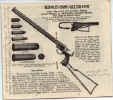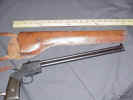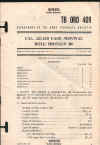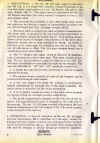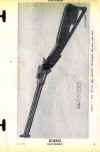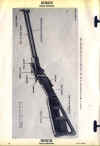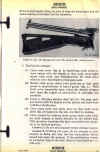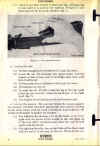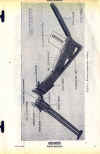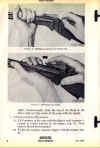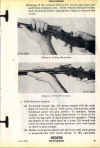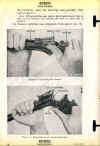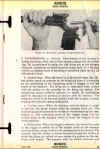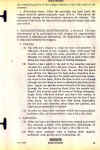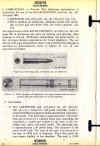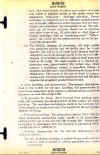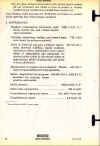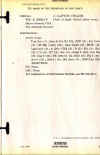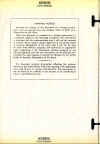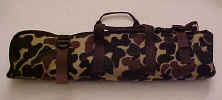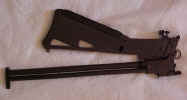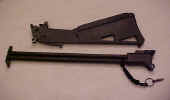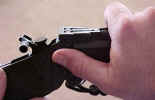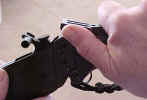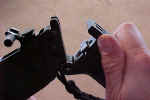Springfield Armory M-6 Scout Survival Gun
UPDATED 06 AUG 2003
(Updated regularly with viewer email)
(Free permission to quote Church's articles is granted, as long as proper attribution is given. We request that if you use our work, you give us credit.)
The concept of the military "survival gun" seems to be fairly recent idea. During World War Two, aircraft, especially bombers, were capable of flying vast distances, assuring crews that wrecks would place them in remote places. These crews would be on their own for foraging, defense, and likely escape.
Combination guns were an obvious approach to gaining versatility. Shotguns allow the taking of birds and small game. Rifle cartridges can be chosen appropriate to other needs.
The Luftwaffe equipped bomber crews working over the Eastern European Theater with the absurdly luxurious Sauer drilling in 12 gauge barrels over 9.3X74R. Manufactured to peacetime commercial standards, the rifle barrel was sufficient to kill anything in Europe. Expense was exorbitant.
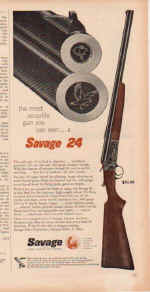
Over the Pacific Theater, the US Air Force issued Stevens (Savage) .22/.410 combination guns of far more humble origin and purpose. Chambered in .22 L.R. over .410 3", these were intended almost solely as foraging guns for small game. I have seen one of these, riding in the motor home of the original WWII issuee. It differs from civilian guns only in having an Ordnance bomb stamped on the receiver near the hammer. Colonel X felt his survival needs did not end with WWII, so that Stevens has soldiered on another 55 years. The .22 L.R. was problematic from a standpoint of Hague Accord rules against expanding bullets, so a bizarre full metal jacketed bullet was devised for this application.
Collectors note: these guns fall into no specific serial range-by virtue of carrying no serial number.
Ultimately the weight, dimensions and rimfire cartridge were all rejected by the Air Force, and in the early '50s, a purpose built survival arm was chosen--the M-6.

It appears to derive in many ways from the Marble's Game Getter, killed off by the National Firearms act of 1934.
Firing a .22 Hornet FMJ over a 3" .410 barrel, the M6 is of all metal construction. Carrying 14-inch barrels (governments always exempt themselves from the laws they impose on serfs), it was capable of being stored easily in the seat pack of a variety of 1950s bombers. A strikingly industrial looking, all aluminum, one piece, cased .410 round also came as part of the package.
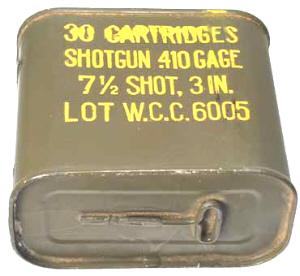
Ooooh. Spam canned .410
It's ugly. All steel, vestigial in the buttstock, it uses a squeeze bar instead of the normal design of trigger which is pressed upward to allow firing by users wearing heavy mittens. A 2 position folding rear sight is theoretically zeroed for the .22 barrel @ 100 yards, and the .410 @ 25yrds. A really neat, well thought out storage bin for ammunition is incorporated in the comb of the buttstock.
Unlatch the top cover of the butt, open that cover, and a quantity of ammo is stored internally in rattle resistant openings.
Buttstock ammunition storage of the M-6 may well have influenced Savage to incorporate a similar feature in their 24-C Camper's Companion.
A few thousand were made in the early '50s by Ithaca and dispersed to the Strategic Air Command. In the period since, a few have exfiltrated to civilian hands and been registered as NFA weapons (Any Other Weapon, $5 transfer tax), and with the START Treaty destruction of B52 bombers, surplus guns have gone on a Diaspora throughout the armed forces. A former co-worker serving in an Army National Guard medical unit noted they carried two in inventory for rodent elimination. In this role they are issued only with .410 ammo.
The Air Force issued a "Technical Bulletin" or field manual for the new survival gun in 1951. Sixgunner.com poster Phat Buoy was kind enough to provide me with a mint copy. It is now reproduced here in its entirety. Thanks, O Phat One.
COMMERCIAL PRODUCTION
and a small addition directly from Springfield Armory
| Springfield Armory M-6 Scout |
|
|
| Weight: 1.8kg | Length: 81.2cm - 45cm
(Folded) | Sights: Adjustable Rear Features:The Springfield Armory Scout is a lightweight sporter rifle, based on the original Air Force M6 Survival Rifle. It has a .22cal barrel and a .410 shotgun barrel in an over/under configuration. The buttstock has a compartment which can hold 9 .22 rounds, and 4 .410 shells. The rifle can be folded in half for transport and stowage. .410 Flares are available from the manufacturer. See Ammo for .410 ammo statistics. Price: Approximatly $170 - $200 US depending on finish (1997). |
|
|
| Make & Model | Subskill | Speed | IA | Fire rate | Hands Req'd | Eff. range | Action | Magazine | Ammo |
| Springfield M6 Scout | Longarm | 4 | 21 | 4 | 2 | 100 | Semi-Auto | 1/1 | .22LR/.410 |
Soldier of Fortune Magazine for March 1984 carried a brief mention that the Springfield Armory firm was going to commence production of a copy of the Air Force gun. These were to be equipped with civilian legal 18 inch barrels, and a range of accessories were to be made available such as slings, .410 flare rounds, padded cases, and ‘scope mounts. The pictured gun was presumably a prototype and carried the same odd sling swivel mounting arrangements the Air Force guns carried. I have never actually seen a commercial M-6 which carried the odd arrangement the Air Force guns had.
this is the other gun a B36 crew would have to forage with
(Click on "Revolvers", then on "Aircrewman")
And there it started. These guns have sold in dribs and drabs, and a few variations emerged before the old Springfield Armory went into bankruptcy. Earliest guns (and I briefly owned a high 3 digit), had no crossbolt safety, and no trigger guard. My longtime user gun is a low 4 digit, and carries the tort-resistant crossbolt safety. Later production saw the addition of the inadequately sized flimsy trigger guard.
 Functionally, this was likely a step backwards. It interferes with the use of gloves, and appears that if dropped, it would jam against the trigger
preventing use.
Functionally, this was likely a step backwards. It interferes with the use of gloves, and appears that if dropped, it would jam against the trigger
preventing use.
A current variation, now produced for Springfield in the Czech Republic, is even available in stainless--an outstanding idea for this sort of deep cached tool.
SHOOTING
( note: Due to the crappy weather we've had the last couple of weeks, targeting had to be suspended until further notice. When the temperature moderates, we'll get some target pix posted. MILESFORTIS)
The unchoked .410 barrel, a really bad idea, was subsequently corrected in later production than mine. Current guns carry a most proper full choke in the lower tube.
My gun was zeroed with Super-X .22LR @ a range of 25 yards. Accuracy is middlin’ at best, and in a survival situation I would likely find myself using the .410 excessively. That said, the useable accuracy of the gun is considerably greater for a slightly skilled user than the snubnose .38 Specials this gun originally augmented. Accuracy is certainly sufficient to allow possum and dog sized animals to be taken at least to 50 yards. The original Air Force chambering of the .22 Hornet allows most big game in North America to be killed, after a fashion. The round has a long time history of poaching use, and a bomber crew crashing in Siberia is already violating Soviet game laws.
One truly terrible design feature is the extractors. Anemic on mine, and anemic on all I’ve ever handled.
MY GUN
Purchased very slightly used in 1987, I have carried it tucked into the recesses of 3 different automobiles. The hammer carries a ‘scope type extension of forgotten brand to ease cocking while wearing gloves. I have also added sling swivels, the rear being mounted on a totally improvised parts-box arrangement.
The padded case it currently calls home is a gun show acquisition intended for the similarly themed Savage Model 24-C. The original Springfield Armory case wore out some while back.
This case is of better quality.
Spare .22 ammunition is carried in MTM plastic wallets tucked into the case. 8 extra rounds of .410/3" #6 are stuffed into a nylon carrier designed for .30-30.
DISASSEMBLY
Some M-6s are held together with a hinge pin retained by E clips. On these, pry off the clip, hopefully not launching it into the nearby sofa, and push out the hinge pin. Pull the barrel section off the receiver. This is the original USAF arrangement.
Under the seat of a B36, it was folded open, but not disassembled.
Mine carries the better still ball detent hinge pin.
Pull the pin out by the attached ring, and...
pull the two sections apart.
The hinge pin on mine is rendered captive by tying a nylon cord through the ring and between the barrels. This pull pin arrangement is far preferable, and is a real improvement over the original design.
This is not a particularly versatile firearm. Canoe paddles aren’t versatile, either, but sometimes they can be entirely comforting to have.
SPECIFICATIONS, TEST GUN:
Type: Breakopen over/under combination gun. Outside hammer. Takedown. Barrels roll pin mounted to monoblock receiver. Automatic extractors.
Caliber: 22LR over .410 3 inch, smoothbore cylinder.
Weight (unloaded): 4 pounds.
Barrel length: 18.25"
Length O/A: 31"
Sights: Front blade integral with barrel brace. Rear 2-position
and notch for
.410. 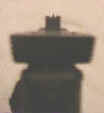
Drift adjustable for deflection. .22 elevation controlled by filing front sight height. Buttstock contains integral storage area for 15 rounds .22LR, 4 rounds .410.
Parkerized finish.
OPERATION OF THE M-6 COMBINATION GUN
Located at the top of the standing breech is the barrel release.
1 Push up on the barrel release.
Since the barrels are capable of pivoting almost 180 degrees, rotate the buttstock section back slightly to expose the chambers.
3 Load chambers. The bottom will be .410 shotgun, the upper may be be either .22LR, .22 Magnum or .22 Hornet.
4 Close the gun.
5 Either before or after cocking the gun, select the barrel to be fired. The hammer incorporates a mushroom shaped projection protruding from the top. This is the barrel selector.
Pull upward for
the rifle barrel,
or push down for
the shotgun barrel.
6. Set rear sight for barrel chosen, aperture for the rifle, and notch for the .410.
7 Some commercial M-6s incorporate a crossbolt safety forward of the hammer. Push this in until the red ring is full inside the receiver.
8 Shoulder the gun. Buttstock pull is SHORT! Cock the hammer.
9 Fire by squeezing upward on the trigger bar. Recoil of the .410 barrel will be sharper than you expect a mere .410 to be.
10 When ready to reload, unlatch the barrels as described in step one. The empties will need to be manually extracted, as the extractor will only raise them a slight distance.
Note: Some later commercial M-6s incorporate combined barrel selector-safeties. On these consult an owner's manual.
Early Marble's Game Getter missing buttstock
The contemplative early years
| RELATED LINKS |
|
V. Shrake's thought out a lot of M6 questions very well: |
|
Lots of generally useful .410 stuff, and well written: |
|
For information on hand-loading the sturdy .410, have a look here (remember that hand-loading is at your own risk): |
|
|
|
AK likes to attach useful or interesting letters from readers to his articles. Please state in your letter if he may use your correspondence. He can do this with or without your name or address, according to your wishes. Email him here.
NOTE: Author Church regrets that he is unqualified to do appraisal, and cannot establish a value on your gun.
See also the new Savage 24 Discussion Board.
Thanks for reviewing this firearm, I found your article well researched and informative. I seem to remember reading in an old American Rifleman ('70's vintage?) that the Sauer did not see general Luftwaffe issue. While used in some theatre's they tended to be presented to aces and such like by Goering who was a keen hunter. They also apparently came with a very nice Aluminum solid trunk. I have just purchased a slightly used M6 .22 mag/.410 Springfield Armory Model. All I have to do now is sit out XXXXX's stupid XXXXXXXX day cooling off period.
signed: X. purposely anonymous
by request for obvious politically charged & stupid reasons like retribution
from the sender's firearms approval board or, some such idiocy. MILESFORTIS
We carried the M-6 in our survival kits on the F-102A during the mid-1960s in the United States. As a fighter pilot, one of my additional duties was as our small arms training officer. As an active hunter and shooter, I instigated a training program for the M-6 in our squadron. Prior to this, our only training was with the K-38 pistol. We never had a formal requirement for M-6 training, but I provided both shooting with the 410 and the 22 Hornet for our pilots.
We tried many rounds of 410 #9 shot on our skeet range. Most of us got fairly good from station 1 and 7, but any attempt to track a crossing shot was almost hopeless. We concluded that in a survival condition that the 410 should be reserved for stationary targets, i.e. birds or small animals sitting still. This was very useful knowledge, as it would prevent wasting ammunition in a critical environment.
I was able to acquire 410 rifled slugs, which we learned to shoot. These we felt might be very import as we usually flew over northern Washington State and Canada. Survival in that part of the world could easily include the killing of larger game for food. The rifled slug might have been just the ticket. We included ten of these rifled slugs in our survival kit along with the issue #7 ½ shot and 22 Hornet rounds.
I found the 22 Hornet to be outstanding, considering the short stock and short barrel on the M-6. We fired it out to 100-yards with great success. I recall taking one on a survival-training trip into the Cascade Mountains of Washington. We had been dropped off at a high mountain lake by our rescue helicopter and left to “survive” for the weekend. During this survival trip muskrats made frequent trips across the lake in front of us. I would guess the range averaged about 125 yards. With very little effort we were able to put the 22 Hornet right at the head of the wake these swimmers made as the crossed from side to side. I don’t think we ever hit one, but the point of impact was so close to the muskrat that we only knew we had missed by the eventually continued wake. However, anything larger than a muskrat would have been fairly easy to hit at that range.
I left this squadron in 1965 when I was transferred to Germany flying the F-102s there. For reasons I cannot explain, we were not equipped with the M-6 in Europe, but with the M1911 pistol when required. In 1968, I returned to my original fighter squadron, which had been transferred to the Philippines and flying missions out of two Vietnam bases. To my surprise and disappointment, the M-6 had been removed from our survival kits. I never found out why. We carried the K-38 pistol as part of our vest gear. No gun was included in the survival kits.
I considered the M-6 a fine little gun that with a modicum of training became a fairly powerful weapon. Fortunately, none of us every had to prove this in a survival environment. However, in the years between 1958 and 1965 we lost too many aircrew members in the northern Washington area (Okanogan Wilderness Area) and Canada from the fighter squadrons assigned to our other northwestern bases. Many of these pilots were never found. Survival radios were to change that deplorable condition, but I always felt the little M-6 could make the difference, if push came to shove. I considered it a fine compromise weapon, made small enough to fit in our survival kits, and simple enough to use so that pilots could become proficient with reasonable training.
I should point out that during the Cold War we pulled many days of alert. On the weekends, with about 25% of our aircraft on alert, we had the time to do “non-flying” training. We could take part of the Alert Force over to the on-base skeet and target range and “play” with the M-6. That “play” developed into some meaningful training. The only cost was the ammunition. The pilots were available because of their Alert status. Most of our pilots were active hunters and shooters and the challenge of learning to shoot the M-6 was intriguing to them. We even tried to shoot full rounds of skeet, but found that our scores were near zero between stations 2 and 6. We developed a modified skeet competition using just station 1 and 7. I can’t remember about station 8, but I think that was impossible, too.
Thanks for your Web Site, http://www.milesfortis.com/church/akc13.htm. It was fun to read about the M-6 again. It was a piece of the aviation history that received far too little attention, including the lack of a formal training requirement from higher headquarters. I can't help but wonder if it might have made the difference to some fighter pilots during escape and evasion in Vietnam. We will never know.
Sincerely, George Sewell, Lt. Colonel, USAF, RET
Mr. Church,
You might want to amend my email letter. I recalled we used 7 1/2 shot size in the 410 shotgun. However, I have since read your manual and see that #6 shot was the issue shot size. I suspect that was right. I do recall we bought #9 shot to use on the skeet range, as the issue shot did not perform satisfactorily on the airborne clays.
George Sewell
IN YOUR ARTICLE YOU MENTIONED THE POSSIBILITY OF LOSING THE HINGE PIN AND CONTRIVED THE KEEPER ARRANGEMENT.AN ALTERNATIVE WHICH I USED IS TO ORDER AN EXTRA PIN AND STORE IT IN THE BUTTSTOCK WELL USING SOME DUCT TAPE WRAPPED AROUND IT TO MAKE IT FIT SNUGLY IN ONE OF THE SPACES PROVIDED FOR A .22 HORNET. ABOUT THE ONLY HAMMER EXTENSION WHICH I FOUND THAT WOULD FIT IS ONE FOR A BROWNING BLR LEVER ACTION.IT LOOKS GOOD AND IS VERY FUNCTIONAL BUT REQUIRES SHIMMING WITH A SMALL PIECE OF ROUND STOCK. I RECENTLY FOUND WHAT I CONSIDER TO BE AN EXCELLENT .410 LOAD FOR THIS GUN.NATCHEZ SHOOTER'S SUPPLY IN CHATTANOOGA,TN. SELLS A LOAD MANUFACTURED BY SELLIER&BELLOIT.IT IS A 3 INCH .410 CONTAINING 5 PELLETS OF 00 BUCKSHOT.I HAD PREVIOUSLY FOUND SOME WINCHESTER MANUFACTURE 2-3/4" SHELLS CONTAINING 3 PELLETS OF 000 BUCK BUT I CONSIDER THE 3" LOAD WITH TWO MORE PELLETS TO BE A MUCH BETTER LOAD ALTHOUGH THE PELLETS ARE SLIGHTLY SMALLER. INCIDENTALLY THE WINCHESTER LOAD IS SUPPOSED TO BE A "ONE OFF" LOADING. NEEDLESS TO SAY I AM VERY TAKEN WITH THIS LITTLE GUN AND AM CONSTANTLY LOOKING FOR IMPROVEMENTS OR ADDITIONS. I WILL NOT HOWEVER ADD ANY KIND OF SCOPE.I FEEL THIS DESTROYS THE "LOOK" OF THE GUN. PLEASE STAY IN TOUCH AND FAVOR ME WITH ANY FURTHER WRITINGS ON THIS GUN.
STAN WARD
Some forty years ago as a young man I was so desirous of owning one of the M-6 survival rifles. Two years ago I learned that Springfield was offering this little gun. It is made by CZ. I ordered one and have been extremely pleased with it. It has quickly become my "Walk in the woods gun". When you consider what these guns were intended for you fully realize they have certain limitations by their very design. They are not "MOA shooters" nor are they skeet specials. They are mainly target of opportunity type weapons. Mine is .22 Hornet over, of course, .410. I find this combination quite fills the bill for anything I might encounter in the woods. Your evaluation was, I felt, somewhat less than fair in that you attempted to apply the abilities of other weapons to the performance of this one. The only possible comparison would be the Savage model 24 and in my opinion, having had three or four 24's, the M-6 beats that hands down. I am very appreciative of your publishing the manual which I will copy for reference. Thanks.
Added 04-21-2002:
a.k.-stumbled onto your website and really enjoyed the m-6 section. i've got one in stainless...22 over the 410. i just sent it back to springfield to have them replace the stainless sights with the matte blue ones...something they shoulda done in the first place and also is how the stainless model is shown in their ads. ( you stainless m-6 owners ought to complain to springfield....maybe they'd fix it ) i plan on getting another in 22 hornet. was wondering a couple of things: the picture on your website showed a hammer extention.....was that for a browning blr lever like one of the letter writers mentioned? if not, what did you use? sometimes when you cock the gun intending to fire in the .22 mode, your thumb depresses the barrel selecter into the neutral mode. CLICK. very disappointing, unless of course you happen to be a red squirrel on my bird feeder! also, how did you cobble up a rear swivel mount? has anyone tried to improve the sights on this gun? i enlarged the peep sight somewhat by drilling it out a little, which helps me some. i just wish there was some way of putting a gold bead on the front sight but i'm not sure how to go about it. it's a nice little gun but could use a little tweaking. the first thing i did was remove that bogus trigger guard. one other thing....your hinge pin: did it come with that ring or did you add it? springfield armory says they don.t have any parts for this gun as it's made in that eastern european country i can't spell. i wonder if anyone has their address? thanks again for your website and for any answers you might find time to provide. use this letter if you want. tony
AK answers:
I'm working from memory on a lot of this. I set the gun up in '87, and other than slings, pretty much haven't changed it.
(1) The hammer extension is a parts box special, so I'm not sure what it originally fit. At the time I was using a Browning BL-22, a Savage 24, and a Marlin 336, so those are the likeliest bet. I think the extension was a Williams, not an Uncle Mike's.
(2) The rear swivel base was originally intended for the strut of a folding shotgun stock. It was machine threaded for an inch and a half, so I drilled an access into the plastic stock insert, and retained it with a nyloc nut. I had to grind down an open end wrench to get inside the stock, so I could capture the nut while attaching the whole deal. I got my base from a long extinct Montana vendor, but they likely are still available from Uncle Mike's or Choate's. They were plentiful back before George Bush Senior decided to disarm law abiding citizens of so-called assault weapons.
Executive
Order 12680
Administration of foreign assistance and related
functions and arms export controls
Signed: July 5, 1989
Federal Register page and date: 54 FR 28995; July 10,
1989
Amends: EO 11958, January 18, 1977; EO 12163,
September 29, 1989
(3) Not sure what to do on the rear sight. It's possible that a Williams or Lyman aperture rear sight intended for another application might be mounted on the barrel monobloc, I think. You're definitely looking at dialoguing with your gunsmith.
(4) I suspect, but again am not a gunsmith, that the front sight could be milled down to a base, grooved fore and aft, and a front sight fabricated of steel flat stock. The front sight would be attached via a transverse pin. This could have brass or steel wire inset for reference points.
(5) The ringed pin was a factory option in the '80s. A 'smith shouldn't have much trouble building a new one. It was a straight piece of steel round stock, drilled at one end for the ring, and at the other carrying a spring loaded ball staked in place. Pretty simple.
(6) Lack of parts for old production is news to me, but I guess unsurprising. The old company has gone through a bankruptcy. Have you tried Gun Parts Corporation or Sarco?
(7) I am surprised to discover I can't find an address for CZ in the Czech Republic, but I'm still looking.
Thanks, Alan Karl Church
Mr. Church,
You have some interesting comments on the M6 Scout Rifle. You have
obviously put a great deal of thought and experimentation into your rifle.
I have a new Springfield Armory .22 LR version that is a remarkable shooter
(1/2" @ 50 yds) but the Springfield does need some work to make it more
functional.
The trigger guard needs to come off so it will fold in half but I am not sure
if I pry the sheet metal stock apart to get the pin lose if I will loosen any
internal parts. Have any of your contacts removed a Springfield M6
trigger guard? If so, how did they do it?
Also, the stainless steel M6 is too shiny and in one of the letters you
responded to you talk about purchasing a blued rear sight and having a new
front sight made. I think there is a simpler fix, although I have not
tried it yet. Brownells carries several spray-on finishes that are
industry standard gun finishes that can be used at home and I think one can
even be baked on in your oven. I do not have a catalogue but I found it
on Brownells WEB sight so one would have to visit Brownells to find out all
the details. The better finishes are expensive, about $25.00 a can (if memory
serves me correct), but that is a lot cheaper than having a new front sight
made.
Thank you for the info!
Added 27 March 2003:
Terri sends us this advice on how to remove the trigger guard on the newer M6s to create a more original appearance and function:
It ain't pretty, but its do-able. Just CAREFULLY pry open the bottom of the stock/receiver to remove cross pin. Remove pin, trigger guard then pivots out. Squeeze the receiver back "straight" and it "works like it was supposed too."
visitors since website crashed AUG
2003

